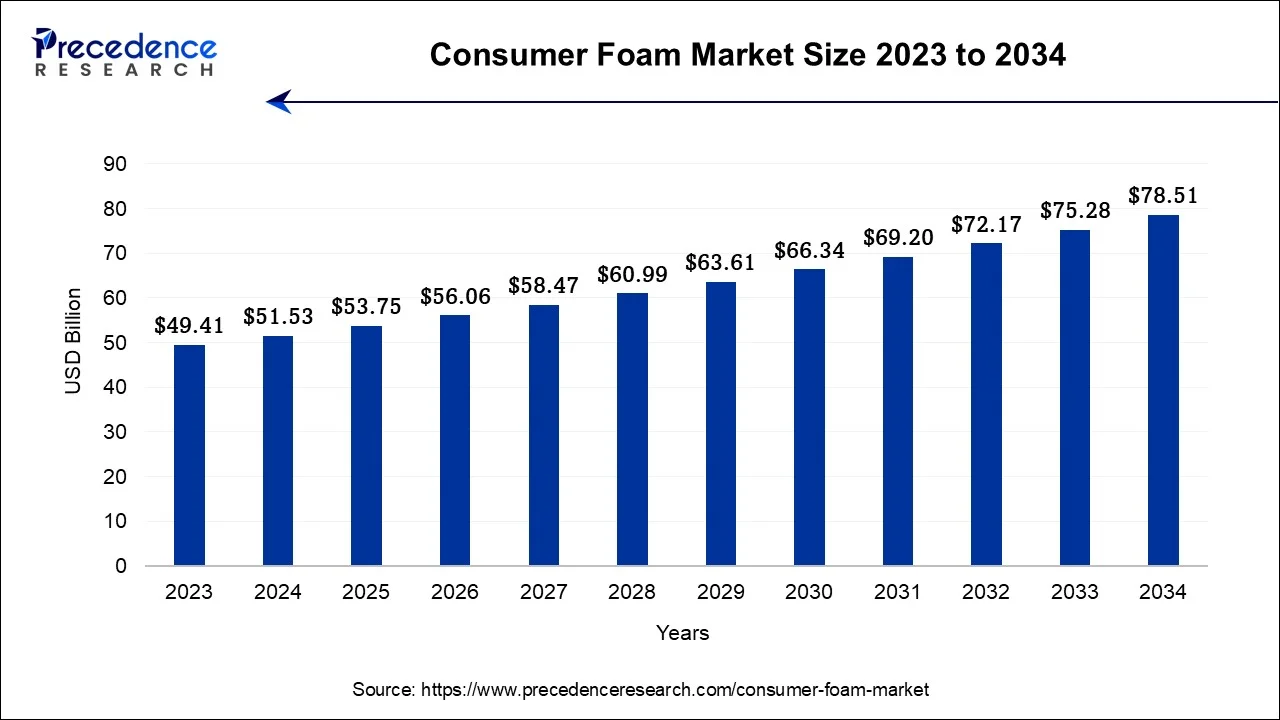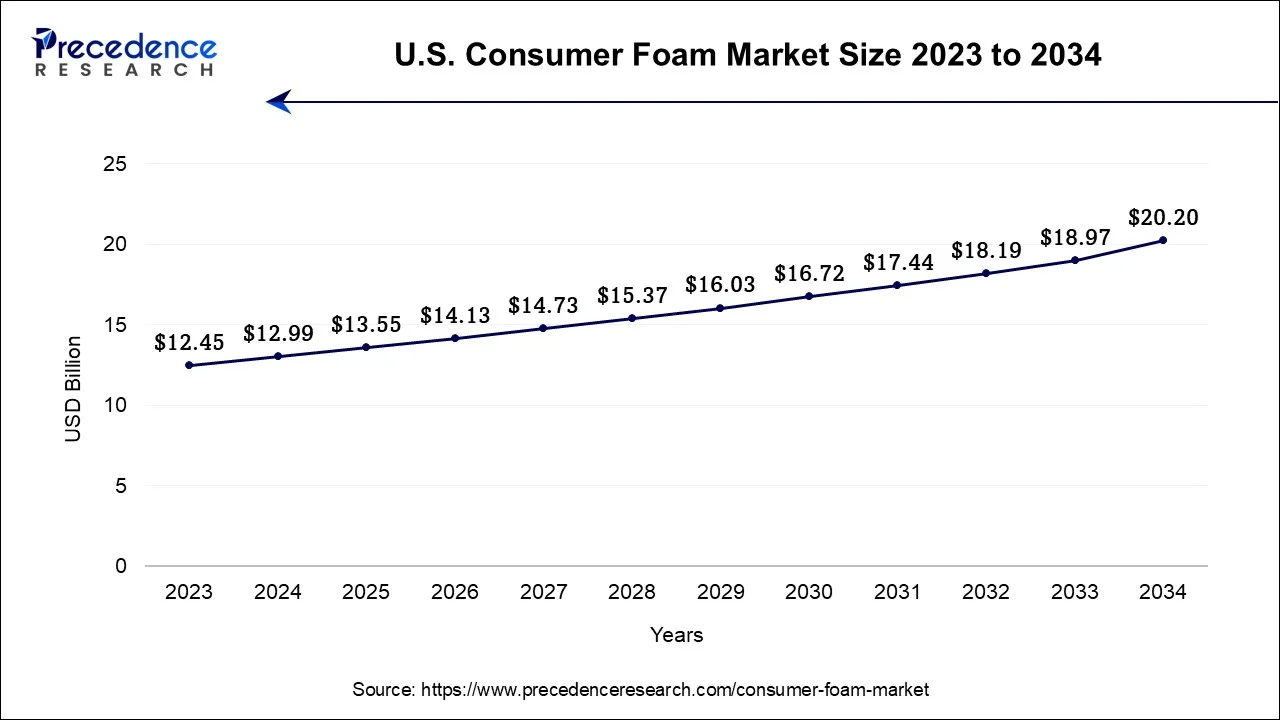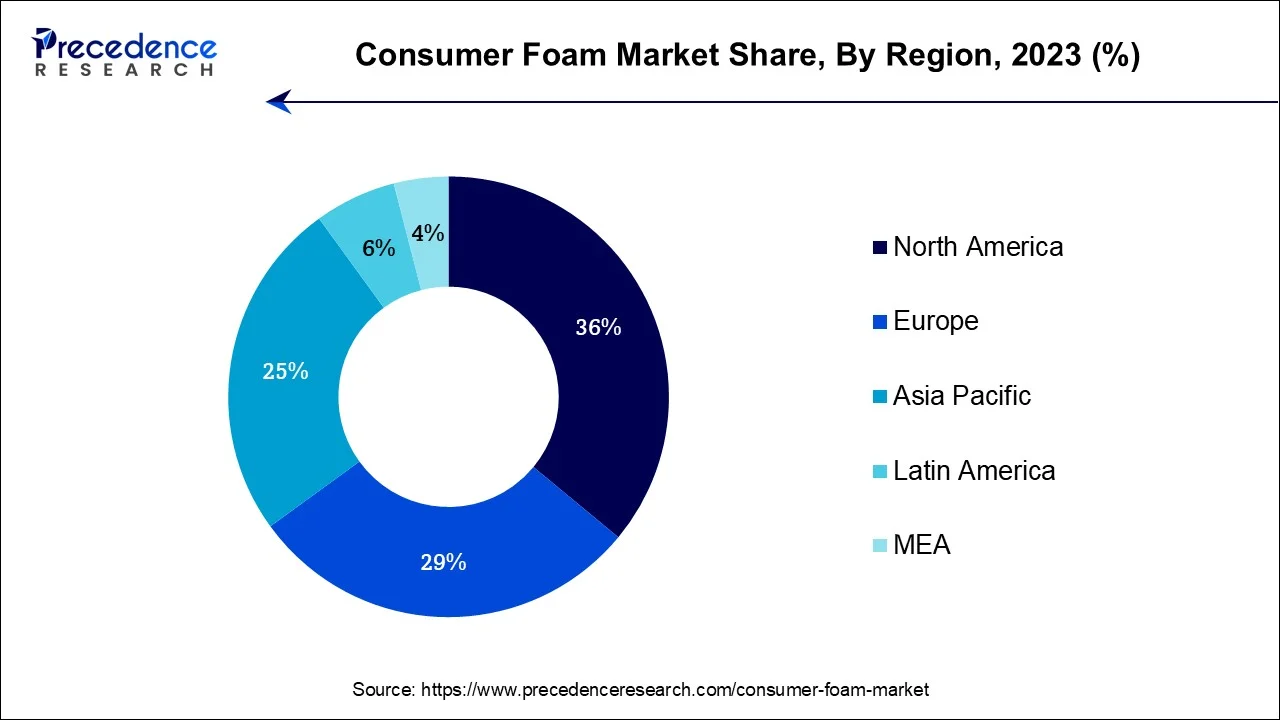January 2025
The global consumer foam market size accounted for USD 51.53 billion in 2024, grew to USD 53.75 billion in 2025 and is projected to surpass around USD 78.51 billion by 2034, representing a healthy CAGR of 4.30% between 2024 and 2034.
The global consumer foam market size is estimated at USD 51.53 billion in 2024 and is anticipated to reach around USD 78.51 billion by 2034, growinmg at a CAGR of 4.30% between 2024 and 2034.

The U.S. consumer foam market size accpunted for USD 12.99 billion in 2024 and is expected to be worth around USD 20.20 billion by 2034, at a CAGR of 4.51% from 2024 to 2034.

North America held the largest revenue share of 36% in 2023. In North America, the consumer foam market is witnessing notable trends. There's a growing emphasis on eco-friendly foam materials as consumers increasingly prioritize sustainability. Customization is gaining traction, with consumers seeking tailored foam products like mattresses and pillows for individual comfort needs. Additionally, e-commerce is reshaping the retail landscape, with online sales channels offering convenience and a wide range of foam-based options. The health and wellness sector's growth is driving demand for foam-based products designed to address sleep and orthopedic concerns. These trends collectively reflect consumers' evolving preferences for comfort, sustainability, and personalized experiences in foam products.
Asia-Pacific is estimated to observe the fastest expansion In the Asia-Pacific region, the consumer foam market is marked by several noteworthy trends. Increasing urbanization and a rising middle-class population have led to greater demand for comfort-centric products, including mattresses and furniture cushions. There is a growing preference for eco-friendly and sustainable foam materials, reflecting heightened environmental awareness. Customization options are gaining popularity, driven by consumer preferences for tailored comfort experiences. Furthermore, the rapid expansion of e-commerce platforms is transforming the way consumers shop for foam-based products, offering convenience and a vast product selection, contributing to market growth in the Asia-Pacific region.

In Europe, the consumer foam market is witnessing notable trends. A growing emphasis on sustainability is leading to increased demand for eco-friendly foam products. Customization options are gaining popularity, with consumers seeking bespoke foam solutions for enhanced comfort. Technological innovations are driving product quality, with a focus on durability and performance. The expansion of e-commerce is revolutionizing the way consumers shop for foam-based products, providing convenience and a wider range of choices. Overall, Europe's foam market is evolving to meet consumer demands for sustainability, customization, and superior quality in foam-based items like mattresses, pillows, and furniture cushions.
| Report Coverage | Details |
| Market Size in 2024 | USD 51.53 Billion |
| Market Size by 2034 | USD 78.51 Billion |
| Growth Rate from 2024 to 2034 | CAGR of 4.30% |
| Largest Market | North America |
| Base Year | 2023 |
| Forecast Period | 2024 to 2034 |
| Segments Covered | By End-Use and By Resin Type |
| Regions Covered | North America, Europe, Asia-Pacific, Latin America, and Middle East & Africa |
Innovations in foam technology significantly drive market demand for the consumer foam industry. Advancements in foam formulations and manufacturing processes have led to the creation of products with enhanced performance, durability, and temperature regulation. These innovations resonate with consumers seeking superior quality and comfort in mattresses, pillows, furniture cushions, and other foam-based items. As manufacturers continue to push the boundaries of foam technology, consumers are drawn to these cutting-edge solutions, fueling market growth and cementing foam's position as a preferred material for comfort and support. Moreover, innovations that enhance comfort and support in foam-based products are driving market demand in the consumer foam market.
Consumers increasingly seek superior quality items like mattresses and furniture cushions that provide enhanced comfort and support, promoting better sleep and overall well-being. Continuous advancements in foam technology and formulations, including memory foam and specialized contouring, offer innovative solutions that cater to these needs. As consumers prioritize comfort in their lifestyles, the market responds with innovative foam products, boosting demand for these higher-performing and customized offerings.
Environmental concerns pose a restraint on the consumer foam market by pressuring manufacturers to address sustainability issues. Foam products, particularly those made from non-biodegradable materials, contribute to waste and pollution concerns. Compliance with stringent environmental regulations, including restrictions on certain foam types and disposal practices, can increase production costs. Consumers, increasingly eco-conscious, may opt for alternative materials perceived as more sustainable, impacting the demand for foam products.
Balancing the performance benefits of foam with environmental responsibility is a challenge the industry must navigate to meet evolving consumer expectations. Moreover, Regulatory compliance poses a restraint on the consumer foam market by imposing strict standards and safety requirements.
Manufacturers must invest in research, testing, and certification processes to ensure their foam products meet these regulations, increasing production costs. These added expenses can be passed on to consumers, affecting pricing and market affordability. Additionally, the need to adhere to different regulations across regions and countries can create logistical challenges for manufacturers, hindering market expansion and potentially limiting consumer choices due to compliance-related constraints.
Sustainable materials are driving market demand in the consumer foam market as consumers increasingly prioritize eco-friendly choices. Products made from biodegradable and recyclable foam materials resonate with environmentally conscious consumers seeking sustainable options. This surge in demand reflects a growing awareness of the environmental impact of foam products and a desire to reduce carbon footprints. Manufacturers that invest in sustainable materials not only meet this consumer demand but also position themselves as environmentally responsible brands, thus experiencing heightened market appeal and growth. Moreover, Customization surges market demand in the consumer foam market by catering to individual preferences for comfort and support.
Consumers seek personalized foam solutions tailored to their unique needs, whether it's a mattress with specific firmness levels or a pillow designed to relieve pressure points. Offering customizable options allows manufacturers to address these diverse requirements, enhancing consumer satisfaction and loyalty. This focus on individualized comfort experiences drives consumers to invest in foam products that align precisely with their expectations, boosting market demand for such tailored solutions.
According to the resin type, Polyurethane has held 38% revenue share in 2023. Polyurethane, a versatile foam resin, is a key player in the consumer foam industry. Polyurethane, a versatile foam resin, is highly regarded for its exceptional comfort and support attributes. This makes it the top choice for crafting mattresses, pillows, and furniture cushions in the market. Trends show a growing demand for eco-friendly, low-VOC (volatile organic compound) polyurethane foam materials. As sustainability gains importance, manufacturers are exploring bio-based and recycled polyurethane options. Additionally, innovations in memory foam and high-resilience foam formulations continue to enhance consumer comfort experiences.
The polyolefins segment is anticipated to expand at a significant CAGR of 6.2% during the projected period. The polyolefins, a type of polymer derived from olefin monomers, play a significant role in the consumer foam market. Current trends involve the development of sustainable polyolefin foams, utilizing recyclable and biodegradable variants. Additionally, advanced manufacturing techniques are enhancing the performance of polyolefin-based foams, leading to increased demand for applications in mattresses, packaging, and furniture cushions.
The bedding and furniture segment held the largest market share of 34.5% in 2023. In the consumer foam market, bedding and furniture are end-use segments encompassing foam applications. Bedding includes mattresses and pillows, with trends favoring memory foam for better sleep quality. Furniture, including sofas and chairs, utilizes foam cushions for enhanced comfort. Eco-friendly and sustainable foam materials are increasingly sought after in both segments, reflecting a growing awareness of environmental concerns. Customization options for mattresses and furniture cushions are also on the rise, catering to individual comfort preferences.
On the other hand, the automotive segment is projected to grow at the fastest rate over the projected period. In the consumer foam market, the automotive sector is a significant end-use segment that utilizes foam materials for various applications. These include seating, interior components, and sound insulation. Current trends in this sector involve an increased focus on lightweight and sustainable materials to enhance fuel efficiency and reduce the carbon footprint of vehicles. Foam innovations that offer both comfort and environmental benefits are thus gaining prominence in response to these automotive industry trends.
Segments Covered in the Report:
By End-Use
By Resin Type
By Geography
For inquiries regarding discounts, bulk purchases, or customization requests, please contact us at sales@precedenceresearch.com
No cookie-cutter, only authentic analysis – take the 1st step to become a Precedence Research client
January 2025
August 2024
November 2024
October 2024